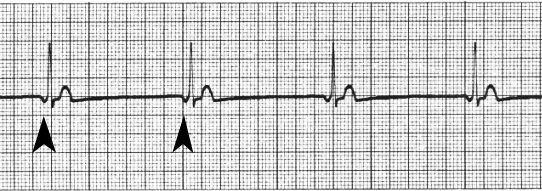Description
Junctional rhythms occur when the AV node takes over as the primary pacemaker site in the heart either because the SA node has failed or the AV node is going faster and over takes the SA node. Junctional rhythms are classified as follows:
- Juntional Rhythm, rate is 40-60 beats per minute
- Accelerated Junctional Rhythm, rate is 60-100 beats per minute
- Junctional Tachycardia, rate is greater than 100 beats per minute
When a junctional rhythm (rate 40-60 beats per minute) occurs, it is actually a backup pacemaker and is a design feature of the heart. Without a backup, when the SA node fails, the heart may stop. Depending on the heart rate, patients with junctional rhythms may complain of slow rates, lightheadedness or dizziness if the rate is slow or rapid rates if the rate is fast. Treatment is directed at first determining the underlying cause and then taking appropriate action.
In the above example, the PR interval is very short (.06 seconds vs a normal of .12-.20 seconds) and the P wave is inverted (it is actually merging into the front of the QRS complex). The first two P waves are shown by the arrows. The presence of inverted P waves indicates that the primary pacemaker has shifted to the AV node (in this case probably high in the AV node). The heart rate is 41 beats per minute.

